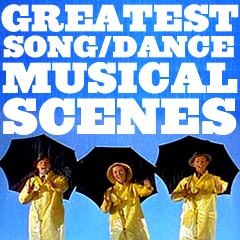
|
Musical Moments and Scenes S - 2 |
| S (continued) | |||||||||||

|
The Singing Fool (1928)
This even more successful Warners' film (and Vitaphone) was star Al Jolson's follow-up to The Jazz Singer (1927), and it was responsible for bringing the reality of talkie-musicals to the movie-going public. Its main song Sonny Boy became the first song from a movie to sell over a million dollars worth of records. The part-talkie movie, one of cinema's earliest musicals, was a sentimental musical melodrama best known for Jolson's role as singing waiter (at Blackie Joe's cafe) and future Broadway star Al Stone. He delivered heart-tugging renditions of:
|
   
|
|||||||||
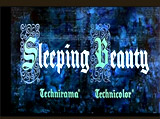
|
Sleeping Beauty (1959) Disney's beloved musical fantasy Sleeping Beauty was the studio's 16th feature animation. It was significant for being the last fairy tale to be adapted into an animated film - until 30 years later (with the release of The Little Mermaid (1989), based upon Hans Christian Andersen's Danish fairy tale, and marking the start of the so-called Disney Renaissance). Much of the film's musical score was adapted and derived from the works of composers Tchaikovsky and Stravinsky. It was nominated for Best Musical Score (George Bruns). The tale was about the evil doings of a malevolent fairy known as Maleficent, who placed a curse on Princess Aurora (voice of Mary Costa). She was destined to prick her finger on a spinning wheel on her 16th birthday and go into a "sleeping" death. Only the true love of handsome Prince Phillip (voice of Bill Shirley) could end the evil spell. Three good fairies Flora, Fauna, and Merryweather assisted the imprisoned Prince and "death-like" Sleeping Beauty to be reunited. It featured the dreamlike song Once Upon A Dream (pictured twice) that captured the romantic love between the Princess and the Prince in the forest - it was played during the opening titles and reprised in the film (most prominently in the happy-ending finale):
|
 
|
|||||||||

|
Slumdog Millionaire (2008, UK)
This Best Picture winning film had a total of ten nominations (with eight Oscars, but remarkably not a single nomination for acting roles), including Best Director (Danny Boyle), Best Adapted Screenplay, Best Cinematography, Best Musical Score, Best Original Song, Best Film Editing, and Best Sound Mixing. It told about the exploits of "Who Wants to Be A Millionaire" TV game-show winner of 20 million rupees Jamal Malik (Dev Patel). In the film's feel-good happy ending, Jamal danced on a train platform (between two parked trains) with his life-long, elusive, finally-rescued alluring girlfriend Latika (Freida Pinto) - both were positioned in front of dozens of other dancers - to the tune of the Oscar-winning Best Original Song Jai Ho (pictured often). The song continued to be heard during the end credits. |
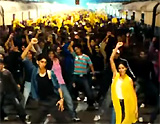  
|
|||||||||

|
Small Town Girl (1953) MGM's musical romance, a remake of the similarly-titled 1936 film with Janet Gaynor, featured imaginative choreography by Busby Berkeley, including the incredible hopping "Street Dance" number. In a number called Take Me to Broadway (pictured thrice), Ludwig Schlemmer (Bobby Van), wearing a white suit with a white carnation, happily became an energetic human pogo stick, literally bouncing and jumping his way through the small town (MGM's backlot) - across a street and over the lawns of various houses. He interacted with passerbys, a milkman, a flower vendor, a mailman, a shoeshine boy, a sweeper, a wooden Indian, and a horse pulling a fruit and vegetable wagon. At one point, he clanged two garbage can lids together, jumped and danced with a little girl and a dog, and gathered a large crowd of people following him. The film's other memorable number was:
|
    
|
|||||||||
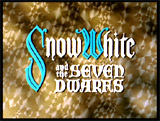
|
Snow White
and the Seven Dwarfs (1937)
Disney's first animated feature film, nominated for Best Music Score, was a classic landmark in cinematic history through a retelling of the Brothers Grimm's classic 1812 fairy tale. It featured many memorable sweet songs (a total of eight) including:
|
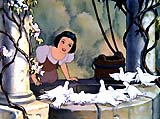  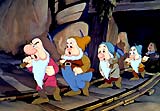    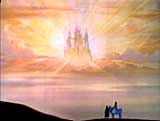
|
|||||||||

|
There were two show-stopping Marilyn Monroe (as Sugar) numbers in this great Billy Wilder comedy:
She also performed her final song, I'm Thru With Love (pictured), in which she soulfully and sadly sang the poignant tune on the bandstand in the cabaret, while Joe/Josephine (Tony Curtis) listened and then came up to her and gave her a goodbye kiss as a female - a moment of sexual exposure, to affirm the bond between them. |
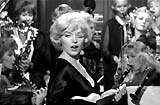 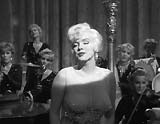 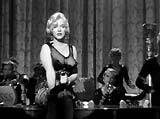
|
|||||||||
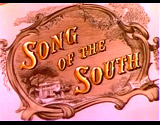
|
Song of the South (1946)
This rarely-seen Disney feature animation with live-action was based on the Uncle Remus cycle of stories by Joel Chandler Harris, mostly about Br'er Rabbit and his enemies, Br'er Fox and Br'er Bear. Of the film's two Oscar nominations for Best Musical Score and Best Song, it won the latter. It contained the popular Oscar-winning Best Song Zip-A-Dee-Doo-Dah (pictured), with music by Allie Wrubel and lyrics by Ray Gilbert. The song was performed by James Baskett (who was the first Disney actor to win an Oscar, albeit an Honorary one) as ex-slave tale-telling Uncle Remus. The song appeared in the first of the film's three short animated segments (and was briefly reprised in the film's conclusion):
The film ended with the cartoon characters (butterflies, Br'er Rabbit, a frog and more) interacting with Uncle Remus and the children (Johnny, Ginny, and Toby) as they skipped along the road toward the horizon while singing "Zip-A-Dee-Doo-Dah." |
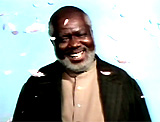 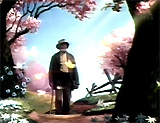 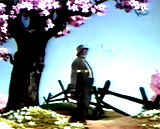 "Zip-a-Dee-Doo-Dah" 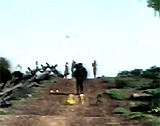 Ending Image |
|||||||||
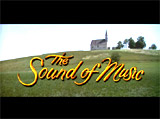
|
Generally considered the most popular musical of the 60s and the film that saved 20th Century Fox studios - this excellent Robert Wise-directed Best Picture-winning film musical featured music and lyrics by Richard Rodgers and Oscar Hammerstein II. It received ten Academy Award nominations, with five wins: Best Picture, Best Director, Best Film Editing, Best Score (Irwin Kostal) and Best Sound. It was adapted for the screen from the successful 1959 Broadway stage musical play about the singing family of Maria Von Trapp in Austria. Its famed iconic soaring, long-range images in the opening scene were breathtakingly taken by a helicopter that swooped down from the clouds for a view of the Austrian Alps and young, mischievous, dimdl-skirted Austrian postulant Maria (Julie Andrews) with arms extended and whirling on a verdent hill, with wildflowers and grass, rotating, dancing and singing the title song The Sound of Music (pictured):
The remainder of the screen musical presented many other standards, including a number of Maria's songs to the Von Trapp children:
The tender and poignant Edelweiss (pictured) was performed by Captain Von Trapp (Christopher Plummer) while strumming a guitar. An adolescent romance was captured in the song Sixteen Going on Seventeen (pictured) between the eldest Von Trapp daughter 16 year-old Liesl (Charmian Carr) and a shy town boy - messenger boyfriend Rolfe (Daniel Truhitte). Maria also arranged two charming songs for performances with the children:
The film ended with the family's stirring flight from Nazis during WWII by ascending over the Alps to the tune of Climb Ev'ry Mountain (pictured). |
     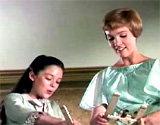  
|
|||||||||
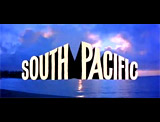
|
South Pacific (1958)
There were many Rodgers and Hammerstein musical numbers in this widescreen Joshua Logan-directed 20th Century Fox film which was shot mostly on location on the Hawaiian island of Kauai. Some of the musical numbers were experimentally filmed with saturated and intensified tinted hues of pink, metallic blue or canary yellow - a much-criticized aspect of the film. It was adapted from the 1949 R and H musical play based on two short stories by James A. Michener from his 1947 book Tales of the South Pacific. The story told of a problematic romance between Mitzi Gaynor (as Navy nurse Ensign Nellie Forbush from Little Rock, AK) and Rossano Brazzi (as French expatriate plantation owner Emile de Becque). It included the hit standards:
|
       
|
|||||||||

|
South Park: Bigger, Longer & Uncut
(1999) Director Trey Parker's R-rated animated musical, set in the small town of South Park, Colorado, was based upon the Comedy Central TV show. The main plot was about four young boys (Stan Marsh, Kyle Broflovski, Eric Cartman, and Kenny McCormick), who were able to sneak into the showing of an R-rated movie:
As a result, their subsequent behavior and language was significantly altered. The feature-length animated film contained about a dozen subversive, profanity-laced songs (written by the series' co-creator Trey Parker with music by Hollywood composer Marc Shaiman). It was notable for having more profanity (and curse words) than any other animated film. Many of the songs ripped off and spoofed traditional theatrical musicals such as Bye Bye Birdie and West Side Story. The most notable songs included:
|
 Film Within a Film ("Asses of Fire") 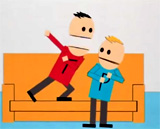 "Uncle F--ka"  "Blame Canada"  "Kyle's Mom's a Bitch"  "What Would Brian Boitano Do?" |
|||||||||
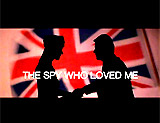
|
The Spy Who Loved Me (1977, UK)
This Bond film was the third film with Roger Moore as James Bond (and arguably with his best performance) - the 10th film in the series. It had the most Oscar nominations (with no wins) of any Bond film to date:
The soundtrack's Nobody Does It Better (pictured twice) followed the spectacular stunt in the lengthy pre-title credits sequence - Bond's downhill ski chase (to evade Russian agents) and jump off a cliff with a Union Jack parachute opening behind him:
|
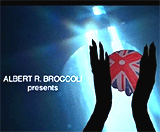 
|
|||||||||
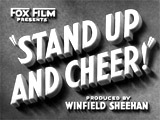
|
Stand Up and Cheer! (1934) Much of this Fox musical feature film was forgettable, as it was composed mostly of a series of vaudeville numbers and musical performances, commissioned by the US President, to boost the US' morale during the height of the Great Depression. The most notable number was:
It was the song-and-dance performance (lyrics by Lew Brown, and music by Lew Brown and Jay Gorney) that really skyrocketed the young child star's career for the studio. |
 
|
|||||||||
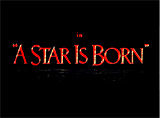
|
Director George Cukor's dramatic epic musical from Warner Bros. was derived from a non-musical version of the William Wellman-directed film of 1937 starring Fredric March and Janet Gaynor (while also borrowing from George Cukor's What Price Hollywood? (1932)). It was filled with Harold Arlen/Ira Gershwin songs showcased by Judy Garland (in her last great tour-de-force role as aspiring Esther Blodgett/Vicki Lester, similar to her own life's rise-to-fame story). However, it lost all six of its Academy Awards nominations: Best Actor (James Mason), Best Actress (Garland), Best Art Direction-Set Decoration, Best Color Costume Design, Best Original Song (The Man That Got Away), and Best Musical Score (Ray Heindorf) The musical numbers were highlighted by Garland's performances:
Other great songs included:
|
 "The Man That Got Away" - In a Late-Night Sunset Strip Dive Bar  "Born in a Trunk" (the beginning and ending song of the film's major production number)  "Here's What I'm Here For" - An Audio Recording Session  "It's a New World"- Sung in a Cheap Motel Room After Their Marriage  "Someone at Last"  "Lose That Long Face" |
|||||||||
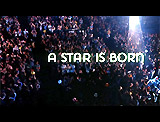
|
A Star Is Born (1976)
In this third film version of the same story (also filmed in 1937 and 1954), now placed in a rock music setting, Barbra Streisand starred as newcomer and aspiring rock star Esther Hoffman. She starred opposite aging, doomed and alcoholic rock star Kris Kristofferson (as John Norman Howard). The musical film had four Academy Award nominations, including Best Cinematography, Best Sound, and Best Musical Song Score (Roger Kellaway). Its sole award was for Best Original Song for the duet Evergreen (Love Theme from A Star Is Born) (pictured), the best known of the repertoire, sung by Streisand and Kristofferson during a recording session. The song was penned by Paul Williams and Streisand:
|
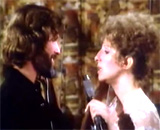
|
|||||||||
(alphabetical by film title) Introduction | A-1 | A-2 | B-1 | B-2 | B-3 | C-1 | C-2 | D-1 | D-2 | E | F-1 | F-2 | G-1 | G-2 H-1 | H-2 | I-J | K | L-1 | L-2 | M-1 | M-2 | N-O | P-1 | P-2 | R-1 | R-2 | S-1 | S-2 | S-3 | T | U-V | W | X-Z |